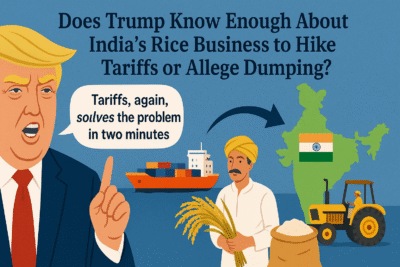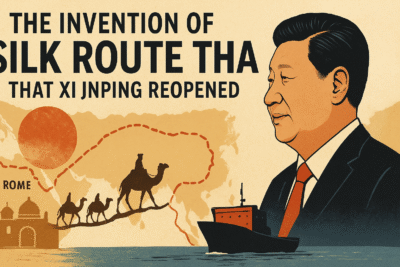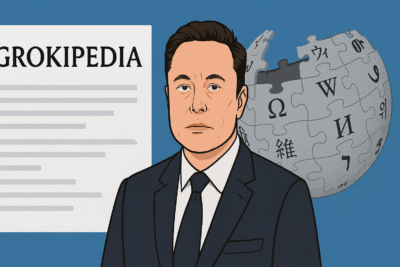
Donald Trump this week announced America got a Liberation Day with his announcement of new tariffs on April 2 (Image posted by Donald Trump on X)
The recent announcement of sweeping tariffs by the Trump administration has sent shockwaves through global markets, with investors rapidly recalibrating their portfolios amid growing concerns of an economic downturn. As Wall Street witnessed its worst trading day in five years—with the Dow, S&P 500, and Nasdaq Composite plummeting 4%, 4.8%, and 6% respectively—the market’s reaction offers telling insights about expectations for the American economy under this new wave of protectionism.
Tariff Turmoil: The New Economic Landscape
The full extent of Trump’s tariff plans was revealed this week, introducing a significant upheaval to global trade. The administration announced a base rate of 10% tariffs on all imports to the United States, effective 5th April, but the policy goes much further with additional “reciprocal tariffs” on select nations. These higher rates, scheduled to begin on 9th April, target countries where Trump claims US exports face inflated prices due to foreign government measures.
— Donald J. Trump (@realDonaldTrump) April 3, 2025
The aggressive nature of these tariffs reflects a significant shift in approach from Trump’s first term. While “Trump 1.0” was often responsive to market concerns, Treasury Secretary Scott Bessent has made it clear that “Trump 2.0” has different priorities, stating, “Wall Street’s done great, but we have a focus on small business and the consumers. So we are going to rebalance the economy”. This signals that investors can no longer count on the “Trump put”—the expectation that the president would reverse course on policies the market doesn’t favour.
Recession Signals: What the Market Reaction Reveals
The market’s dramatic response suggests growing concern about an economic slowdown or even recession. Market probabilities for Federal Reserve rate cuts have surged dramatically, with the probability of at least four cuts this year rising from just 1% in February to 30% currently. Given inflation’s persistent nature—likely to be exacerbated by higher tariffs—such aggressive rate cutting would typically only occur in response to significant economic weakness.
As George Vessey, lead macro strategist at Convera, noted, there is “a new reality of higher domestic prices and weaker growth, owing to Trump’s tariff measures”.
This pessimistic outlook is driving down long-term interest rates, which Treasury Secretary Bessent surprisingly characterised as “one of the biggest wins for the American people”—despite the fact that, as a former macro hedge fund manager, he likely recognises this reflects diminished growth expectations.
Some analysts are more convinced about a recession coming to the US to puncture Trump’s claim of Making America Great Again.
PUT THIS ON BLAST:
Trump’s tariffs just pushed the risk of a U.S. and global recession this year up to 60%—up from 40%, according to J.P. Morgan.
THATS NOT ALL:
The White House made up the numbers—Trump Math 🤡 pic.twitter.com/Y98nhtO266
— Christopher Webb (@cwebbonline) April 4, 2025
The Amazon Paradox: Cyclical or Defensive?
The market’s treatment of Amazon during this sell-off presents a fascinating contradiction. Despite Amazon’s substantial business in everyday essentials, where sales grew 90% faster than the rest of its product selection in 2024, investors punished the stock severely with a 9% decline—far worse than physical retailers like Walmart (down 3%), Costco (flat) or Kroger (up 5%).
This suggests Wall Street views Amazon’s e-commerce business as primarily cyclical rather than defensive, despite its significant presence in essential goods categories. Traditional investment wisdom holds that defensive stocks—those selling necessities like groceries that consumers buy regardless of economic conditions—should outperform during recessionary periods, while cyclical stocks selling discretionary items tend to suffer.
The explanation may lie in Amazon’s product mix and global supply chain. While the company has made impressive strides in essentials and groceries, many of its highest-margin products are electronics and discretionary items imported from overseas, particularly China. These products would face substantial price increases under the new tariff regime, potentially squeezing margins or reducing consumer demand.
Amazon’s position is particularly notable given its recent financial improvements. The company’s North American segment swung from a $240 million loss in 2022 to a healthy $6.4 billion profit in 2023, demonstrating impressive progress in controlling fulfilment costs. However, investors appear concerned that tariff-induced price increases could undermine this progress and push consumers towards brick-and-mortar alternatives.
Amazon was pummeled even worse than many other big tech stocks today.
That shows that investors still consider $AMZN a cyclical tech company, even though it’s been very focused on selling stuff like toilet paper and groceries that people will still need to buy in a recession. pic.twitter.com/2HBVpY4jUn
— Theo Wayt (@theo_wayt) April 4, 2025
Your Favourite Smart Device Maker Gets A Supply Chain Nightmare
If Amazon’s situation appears challenging, Apple’s predicament seems dire. The technology giant saw its shares plummet 9% following the tariff announcement, highlighting the extreme vulnerability of its global supply chain.
Despite years of effort to diversify manufacturing away from China following the 2018 trade war and COVID disruptions, Apple now finds its entire supply network under tariff assault. Most iPhones made in China will face a staggering 54% tariff rate, while production in Vietnam (mainly AirPods, Apple Watch and MacBook models) will incur a 46% tariff. Even operations in India and Malaysia will be hit with 26% and 24% tariffs respectively.
Thinking about it, ironically maybe the biggest victims of the Trump tariffs may end up being American companies.
Take Apple for instance. These guys have spent decades building incredibly complex global supply chains that span dozens of countries.
They can’t just flip a switch… pic.twitter.com/zEbYvIrySt
— Arnaud Bertrand (@RnaudBertrand) April 3, 2025
This comprehensive targeting of Apple’s manufacturing network leaves the company with limited options. It can either absorb the tariff costs—significantly reducing its profit margins on already expensive products—or pass these costs to consumers, potentially reducing demand in a weakening economy.
During Trump’s first term, Apple successfully secured tariff exemptions for many products, including the iPhone, but has thus far been unsuccessful in obtaining similar protections since January.
Market Dynamics: The “Trump Trade” in Action
The current market turbulence represents what Wall Street has dubbed the “Trump trade”—investors positioning themselves based on which industries might benefit or suffer under a Trump presidency. Goldman Sachs analysts note that Trump’s universal tariff plan would likely benefit companies primarily doing business domestically, while hurting those with global operations and supply chains.
This explains why domestic retailers have fared better than companies like Amazon and Apple with significant international exposure. It also accounts for the rise of certain sectors like cryptocurrencies, with companies such as Coinbase seeing their shares rise even amidst the broader market decline.
Many people look confounded by all of what Trump is doing. But the Trump mystery could be unravelled, rather from an unlikely source, a biography of Peter Thiel by journalist Max Chafkin. Read on here
So, What We Conclude: Economic Uncertainty Lies Ahead
The market’s reaction to Trump’s tariff announcements clearly signals concern about economic growth. While some analysts believe the immediate market response may be overstated—with Wedbush arguing that “the bark will be way worse than the bite”[4]—the dramatic shift in rate cut expectations suggests genuine worry about an economic downturn.
For investors, the distinction between cyclical and defensive stocks becomes increasingly important in this environment. Traditional safe havens like consumer staples retailers have demonstrated resilience, while even companies like Amazon with significant essential goods businesses have been punished for their perceived cyclicality and international exposure.
As tariffs begin taking effect in the coming days, market volatility will likely continue as investors reassess growth expectations and inflation projections. The ultimate economic impact remains uncertain, but the market’s initial verdict suggests significant challenges ahead for both global corporations and the broader American economy.




1 thought on “What Markets Tell You About Trump Tariffs: Is a Recession Really Coming?”